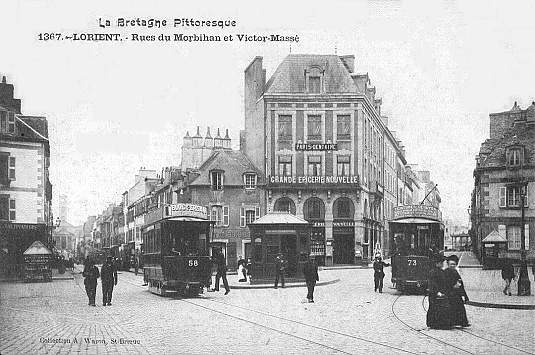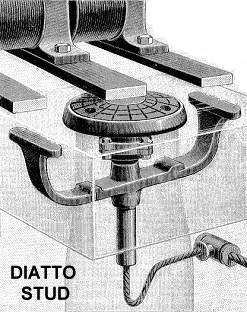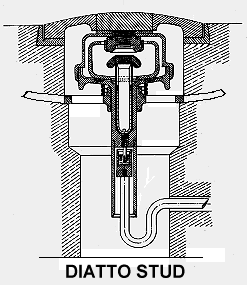

The town of Lorient in Brittany, an important French naval base, was home to this metre gauge tramway of some 32 km of route. This postcard is number 1367 in a series entitled "La Bretagne Pittoresque" from publisher A. Waron of St-Brieuc and our example was posted on 10th September 1906 from Lorient to London.
The tramway opened on 1st January 1901 and consisted of a main line from Keriado to La Perrière via Cours de Chazelles, Rue du Maréchal-Foch and Rue Carnot. From this line there were three branches i.e. Place Bisson - Ploemeur, Place Bisson - Hennebon and Cours de Chazelles - Rue du Pont. Overhead wire current collection was used in the suburbs on the line to Ploemeur, but the majority of the system used the Diatto surface contact stud system. There was a trolley/stud changeover switch under the canopy of the driver's position. Our view shows car 58 on the left with car 73 on the right bound for La Perrière but both have their trolley poles tied down whilst running on the stud section at this junction.
 The Diatto stud system was the most common in France, there being over 20,000 studs in use. It was the invention of Italian Alfredo Diatto of Turin and was first installed in Tours in 1899, followed by four of the Paris tramway companies in 1900. The studs in Tours and most in Paris had gone by 1910 (many there being destroyed by the Seine floods of 28th January that year) but one Paris route continued until 1913. In common with all magnetic stud systems, the power was supplied to the tram from studs laid between the rails which only become live when actuated by an electromagnet carried on the car as it passed. In the Diatto system the tram carried a three part skate (with five electromagnetic coils), the outside two parts forming the south magnet pole and the centre one doubling as the north pole and also making the electrical contact with the stud head, being sufficiently long always to be in contact with at least one stud. The electromagnet coils each had two windings, one for the main power supply via the motor circuit and the other worked from accumulators carried on the tram, (5 to 6 amps at 30 to 32 volts), for energizing the first stud before the car starts.
The Diatto stud system was the most common in France, there being over 20,000 studs in use. It was the invention of Italian Alfredo Diatto of Turin and was first installed in Tours in 1899, followed by four of the Paris tramway companies in 1900. The studs in Tours and most in Paris had gone by 1910 (many there being destroyed by the Seine floods of 28th January that year) but one Paris route continued until 1913. In common with all magnetic stud systems, the power was supplied to the tram from studs laid between the rails which only become live when actuated by an electromagnet carried on the car as it passed. In the Diatto system the tram carried a three part skate (with five electromagnetic coils), the outside two parts forming the south magnet pole and the centre one doubling as the north pole and also making the electrical contact with the stud head, being sufficiently long always to be in contact with at least one stud. The electromagnet coils each had two windings, one for the main power supply via the motor circuit and the other worked from accumulators carried on the tram, (5 to 6 amps at 30 to 32 volts), for energizing the first stud before the car starts.
 The stud itself consisted of six inch diameter soft iron disk laid in an asphalt block and fitted on its underside with a carbon contact. Below this was a cylinder made of ebonite and lined with non-magnetic nickel-steel with a copper stud at its base through which the power was fed in from below. The cylinder contained a pool of mercury in which a soft iron armature, with a carbon contact at its top, "floated". Surrounding this assembly was an iron ring with two horns attached. These horns were just below the road surface and lined up with the south pole sections of the skate, acting as pole pieces to channel the magnetism to the lower area of the stud. When a tram was over the stud the armature was attracted upwards to make electrical connection via the mercury with the stud head and thus to the car. Once the tram had gone the armature fell back by gravity to break the circuit.
The stud itself consisted of six inch diameter soft iron disk laid in an asphalt block and fitted on its underside with a carbon contact. Below this was a cylinder made of ebonite and lined with non-magnetic nickel-steel with a copper stud at its base through which the power was fed in from below. The cylinder contained a pool of mercury in which a soft iron armature, with a carbon contact at its top, "floated". Surrounding this assembly was an iron ring with two horns attached. These horns were just below the road surface and lined up with the south pole sections of the skate, acting as pole pieces to channel the magnetism to the lower area of the stud. When a tram was over the stud the armature was attracted upwards to make electrical connection via the mercury with the stud head and thus to the car. Once the tram had gone the armature fell back by gravity to break the circuit.
The one major problem found with the Diatto system was that mercury would leak out causing the stud to go dead. In addition, once the mercury level fell there was arcing at its surface causing mercury vapour to form which not only allowed current leakage itself, but also condensed onto the insides of the stud destroying its insulation properties and causing the stud to stay live. Additional skates were fitted to the cars to "short circuit" any live studs and blow a fuse in them. In a later design there was even a magnetic arc blow-out coil incorporated into the stud head.
Despite the high fleet numbers on the trams in Lorient, there were in fact only 27 open-platform motor cars (seating 40) and 17 trailers. In 1911, all routes were converted to overhead wire current collection, which it was felt would perform better and be safer in the wet maritime climate of this area. Also in 1911 the route to Keriado was extended to Guidel. Otherwise the system remained unchanged until the mid 1930s when buses replaced trams on the line to Hennebon (1934) and the extension to Guidel (1935). Other lines would have followed but the war intervened, only for the system to be destroyed during the fighting in 1944.
![]() Go to Postcard Of The Month Index
Go to Postcard Of The Month Index